Introduction
Rubber (Hevea brasiliensis) planting material production includes seed germination, seedling maintenance and bud grafting, and all these activities require 18 – 24 months to produce planting materials (Hadi et al., 2013). Vegetative propagation of rubber seedlings are by grafting, where buds (scion) were attached at the rootstock plants. This technique is still the only method of rubber propagation. Grafting was first introduced by van Helten, Bodde and Bags in 1918, and it is still being used because non-conventional technology of planting material production is still has not given the expected results (Djikman, 1951; Hadi et al., 2013). The length of time of this preparation, triggered many research on accelerating the preparation of rubber planting material..
The sound wave technology for plant growth has already begun to be developed in the world. Some studies had shown that the use of this technology could increase plant growth, increase production, improve crop quality, increase plant resistance to disease, and reduce the use of chemical fertilizers (Gutierez et al., 2010; Widyawati et al., 2011; Meng et al., 2012; Zhang and Sanling, 2012). This technology is also applied to the different physiological stage of the plant, such as growth of callus, seed germination, and immature plant (Gagliano et al., 2012; Meng et al., 2012; Wei et al., 2012). Sound waves research in Indonesia had been carried on tea crop, peanuts, soybeans, rice and potato (Ratna, 2002; Kadarisman, et al., 2011; Widyawati et al., 2011; Yulianto, 2011). The result showed that there was an increase in the effectiveness of nutrient uptake and significant improvement growth rate. Sound waves technology which are applied to plants can stimulate the stomata to remain open. This technology was also as one way to increase the rate of photosynthesis and in order to increase the production (Widyawati et al., 2011).
Application of these technologies have not been done in rubber. This technology is expected to accelerate the readiness of rootstock for grafting, thus shorthening the duration of the preparation of rubber seeds can be achieved. Therefore, the objective of this study is to determine the effect of sound wave application to rubber rootstock growth and to find out the suitable frequency of sound wave application to the rubber nursery.
Materials and Methods
This research had been carried out in July to December 2013 at Getas Rubber Research, Indonesia. Planting material used was 1-month-old rubber rootstock in polybag, with soil as a planting medium and fertilizers used were Urea, SP36 and KCl. This research used an insect sounds, Dundubia manifera, we called this “Audio Bio Harmony or ABH”. This insects sound wave frequency was manipulated to 3000 Hz, 3500 Hz, 4000 Hz, 4500 Hz and 5000 Hz, then they were recorded and stored in the flash drive. Another equipment were mono speakers with 3-way speaker sound; paranet 70%; transparent plastic with 1 meter width; ruler and caliper.
Rubber plants in polybag were arranged as shown in Figure 1. The plant was shaded by paranet 70%. The treatment area was covered with transparent plastic so that the plants were isolated from other sound sources. Plants were fertilized a week before the treatment and the subsequent fertilization was performed once a month. Table 1 shows 100% fertilizer dosage on rubber nursery in polybag. Watering was done every day, and regularly inspected for plant pests and diseases. Sound wave treatment was done by turning on a mono speaker for 1 hour every day from 08.00 till 09.00 pm. The research layout is presented in Figure 1.
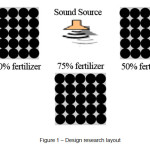 |
Figure 1: Design research layout. Click here to View figure |
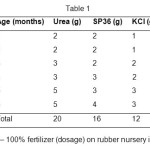 |
Table 1: 100% fertilizer (dosage) on rubber nursery in polybag. Click here to View table |
This treatment used 6 X 3 factorial experiment arranged in a completely randomized block design with 5 replications. The first factor were the frequencies of ABH sound wave. They were 0 Hz, 3000 Hz, 3500 Hz, 4000 Hz, 4500 Hz, 5000 Hz. The second factor were levels of fertilizer dosage, they were 100%, 75% and 50%. Table 1 shows 100% fertilizer on rubber nursery in polybag.
The measured variables were plant height, stem diameter and leaf nutrient status. Observation of plant height and stem diameter was done once a week, for 10 weeks. After the observational data summarized, and then calculated the growth of plant height by calculating the difference between the final plant height with initial plant height, stem diameter growth was also measured by calculating the difference between the final the stem diameter of the bud with the initial stem diameter. At the end of the observation, leaf nutrient status were analyzed for elements of N, P, K, Ca, and Mg. The difference in plant height and stem diameter were analyzed using analysis of variance with a level of confidence 95%. Mean was analyzed with Least Significant Difference (LSD) test.

i = 1, 2, 3, 4, 5, 6; sound wave frequencies
j = 1, 2, 3; fertilizer
k = 1, 2, 3, 4, 5; group
in which:
Yijk : was the observed values of plant height and stem diameter,
μ : was the general average;
αi : was the influence of the i sound wave frequencies;
βj : was the influence of the j level of fertilizers;
ρk : was the influence of kthe groups;
(Αβ) ij : was the interaction between the isound wave frequencies and the j to the level of fertilizers;
εijk : was random error effect of sound wave frequencies and the level of fertilizers.
Results
Treatment Effects on Height Growth
Rubber plant height growth rate on treatment of ABH frequencies and dosage of fertilizers are presented in Table 2. Results analysis showed that the application of sound wave had a significant effect on plant height growth, while fertilizer dosage level had not a significant effect on these variables. Both ABH frequencies and fertilizer did not show any interaction each other. The best plant height growth result was found at 3500 Hz and 75% level of fertilizer (Table 2). Plant height growth at the level of fertilizers 100%, 75% and 50% on 3500 Hz was not significantly different.
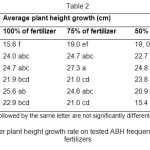 |
Table 2: Rubber plant height growth rate on tested ABH frequency and dosage of fertilizers. Click here to View table |
The relationship between ABH frequencies and plant height growth is presented in Figure 2. The value of the determination coefficient is 0.686, and the curve equation is (Y = -2.10-6 X2 + 0.013 +1.319) (Figure 2). X values that represent the best frequency is 3481.7 Hz, so this can be recommended for height growth of rubber nursery.
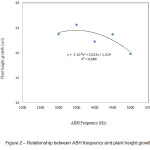 |
Figure 2: Relationship between ABH frequency and plant height growth. Click here to View figure |
Treatment Effect of Stem Diameter Growth
Stem diameter growth rate is affected by ABH frequency and dosage of fertilizers (Table 3). The results showed that the application of sound wave had a significant effect on rubber stem diameter growth, while fertilizer dosage level had no significant effect on these variables. Both factors did not showed interaction with in each other. The best diameter growth was performed at 4000 Hz and 50% level of fertilizer (Table 3). Stem diameter growth at the level of fertilizers 100%, 75% and 50% on 3500 Hz were not significantly different.
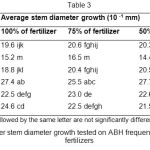 |
Table 3: Rubber stem diameter growth tested on ABH frequency and dosage of fertilizers. Click here to View table |
The relationship between ABH frequency and stem diameter growth is showed in Figure 3. The coefficient of determination value is 0.827, while the equation is Y = -6 .10-8 X 2 + 5.10 -4 X – 0.801. X value that represent the best frequency, so that this frequency can be recommended for rubber stem diameter growth.
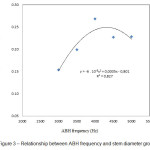 |
Figure 3: Relationship between ABH frequency and stem diameter growth. Click here to View figure |
Treatment Effect on Leaf Nutrient Levels
At the end of the observation, leaf nutrient levels were analyzed. Observed elements in this study were N, P, K, Ca and Mg.
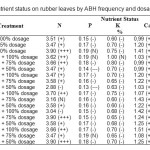 |
Table 4: Nutrient status on rubber leaves by ABH frequency and dosage of fertilizers. Click here to View table |
Based on the analysis of leaves, plant nutrient status varies widely (table 4). The combination of ABH frequency and level of fertilization each gave different results. The content of Nitrogen (N) in the whole plant were in normal to high range. Nutrient content of Phosphorous and Potash in the majority of plants was low indicated by “–“ .Nutrient content of Ca and Mg in the whole plants were high.
Discussion
Several studies had found that incorrect frequency range of sound wave can actually inhibit plant growth. So the first stage of this research objective was to determine the proper frequency of sound wave (ABH) on rubber plant. Desirable treatment results on the rubber nursery are healthy rootstock, big stem, fast growing and it can be bud grafted earlier. Rubber stems with a larger diameter could increase grafting success than smaller stem.
The application of sound wave significantly influence growth rate of rubber plants. According to Carlson (2008), the frequency of the sound wave affected stomatal cavity, thereby increasing water absorption. Stomata have a major role in transpiration. Arve et al., (2011) stated that transpiration rate is directly proportional to the opening of stomata and the number of stomata. The role of transpiration is helping the process of photosynthesis and gas exchange; It plays an important role in rubber plants water cycle; It also helps maintain the balance of carbon dioxide (CO2) and oxygen (O2) in the rubber plant. When stomata were remain open because of certain frequency sound wave stimulation, then the water vapor and oxygen will exchange through the stomata. Thus stimulating the roots for absorbing water from the soil to balance water content in rubber plant. At same the time, during transpiration, it also occurred gas exchange, carbon dioxide gas will enter through the stomata. When all the substances were complete, the process of photosynthesis will occurred.
Some theories concluded that sound wave could affect plant growth in several opinions. The first opinion mentioned that a certain frequency sound wave can activate certain genes in the cell (genes that affect cell growth) (Van Doorne, 2000; Hongbo etal., 2008). The second opinion stated that the frequency of sound wave resonated with stomatal cavity, thereby increasing water absorption during transpiration. The frequency of sound wave also resonate with cell organelles and improve movement in the cell cytoplasm. It can affect the membrane materials to alter the biological function of the cell membrane and increase metabolism. The right sound waves could increase the vibration of leaves and affected the movement of protoplasm in the cells of leaves. While the stomatal vibration remain open, it stimulated the exchange of carbon dioxide and oxygen (Van Doorne, 2000; Collin and Foreman, 2001; Carlson, 2008; Hassanien etal., 2014).
Based on this research, the frequency of the sound waves technology suggested in rubber nursery was 4271,9 Hz that could stimulate greater stem diameter. Fertilizer levels in this study did not significantly affect the stem diameter. More efficient fertilizer application could be recommended to minimize the cost of rubber nursery. This study was a preliminary research of sound wave application technology in rubber plants. It is expected to not only useful in the rubber nursery, but also useful in other aspects of the rubber plant.
Acknowledgements
The author are grateful to Faula Arina, Woro Prawestri, Eka Krisnanti, Dani Indratno, and Bagus Wulandono for their assistance during experiments. The authors also gratefully acknowledge the suport from Yogyakarta State University for this collaboration research.
References
- Hadi H, Afifah E, Admojo L, and Prasetyo N E. In Hendratno S (editor). Prospek teknik okulasi dini dalam penyediaan bibit karet klonal. Pros. Konferensi Nasional Karet: Sept 19-20; Bogor : Indonesian Rubber Research Institute; p. 355 (2013).
- Dijkman M J. Hevea, Thirty Year of Research in the Far East. Univ. Miami Press (Florida). p.329 (1951).
- Gutierez A, Ruiz V, Molto E, Tapia G, and Mar Tellez M. Development of a bioacoustic sensor for the early detection of Red Palm Weevil (Rhynchophorus ferrugineus Olivier). Crop Protection (2010); 29: 671 – 6.
- Widyawati Y, Kadarisman N, and Purwanto A. In Kismiantini, Darmawan D, Priyambodo E, Wijaya A, Nurohman S (editors). Pengaruh Suara “Garengpung” (Dundubia manifera) Termanipulasi pada Peak Frekuensi (6,07±0,04) 103 Hz Terhadap Pertumbuhan dan Produktivitas Tanaman Kacang Dieng (Vica Faba L). Pros. Sem. Nas. Penelitian, Pendidikan dan Penerapan MIPA: Mei 14; Yogyakarta: Yog. State Univ; p. 515 – 521 (2011).
- Meng Q, Zhou Q, Zheng S, And Gao Y. Responses on Photosynthesis and Variable Chlorophyll Fluorescence of Fragaria ananassa under Sound Wave. Energy Procedia (2012); 16 : 346 – 352.
- Zhang F, Sanling F. Review on the development of physical agriculture technology in China. Journal of Engineering (2012); 2(3): 457 – 460.
- Gagliano M, Mancuso S, and Robert D. Towards understanding plant bioacoustics. Trends in Plant Science (2012); 17: 323 – 5.
CrossRef
- ei M, Yang C, and Wei S. Enhancement of the differentiation of protocorm-like bodies of Dendrobium officinale to shoots by ultrasound treatment. Journal of Plant Physiology (2012); 169: 770 – 774.
- Ratna ND. Pengaruh penggunaan getaran suara dan pemberian nutrisi terhadap laju pertumbuhan tanaman teh (Camellia sinensis (L) O. Kuntze) di pembibitan [Thesis]. Bogor: Bogor Agricultural Institute; (2002).
- Kadarisman N, Purwanto A, and Rosana D. In Kismiantini, Darmawan D, Priyambodo E, Wijaya A, Nurohman S (editors). Peningkatan laju pertumbuhan dan produktivitas tanaman kentang (Solanum tuberosum L) melalui spesifikasi variabel fisis gelombang akustik pada pemupukan daun (melalui perlakuan variasi peak frekuensi). Pros. Sem. Nas. Penelitian, Pendidikan dan Penerapan MIPA: Mei 14; Yogyakarta: Yog. State Univ; (2011); p. 453 – 361.
- Yulianto. Sonic bloom sebagai alternatif teknologi terobosan untuk meningkatkan produktivitas padi. Agrosains 8 (2): 87 – 90 (2006).
- Van Doorne Y. The Effects of sound on living organisms application in agriculture. Available from : URL : http://users.belgacom.net/gc681999/Onderwerpen/Info/Ecosonic.htm (2000).
- Hongbo S, Biao L, Bongchu W, Kun T, and Yilong L. A study on differentially expressed gene screening of Chrysanthemum plants under sound stress. C. R. Biologies (2008); 331: 329 – 333.
- Collins ME, Foreman JEK. The effect of sound on the growth of plants. Canadian Acoustics (2001); 29 (2): 3 – 8.
- Carlson D. Twenty Years of Research Creates New Technology to Accelerate the Growth and Yield of Crops. Available from: URL : http://originalsonicbloom.com/background.html (2008).
- Hassanien RHE, Tian-zhen H, Yu-feng L, and Bao-ming L. Advances in effects of sound waves on plants. Journal of Integrative Agriculture (2014); 13 (2): 335-348.
CrossRef
